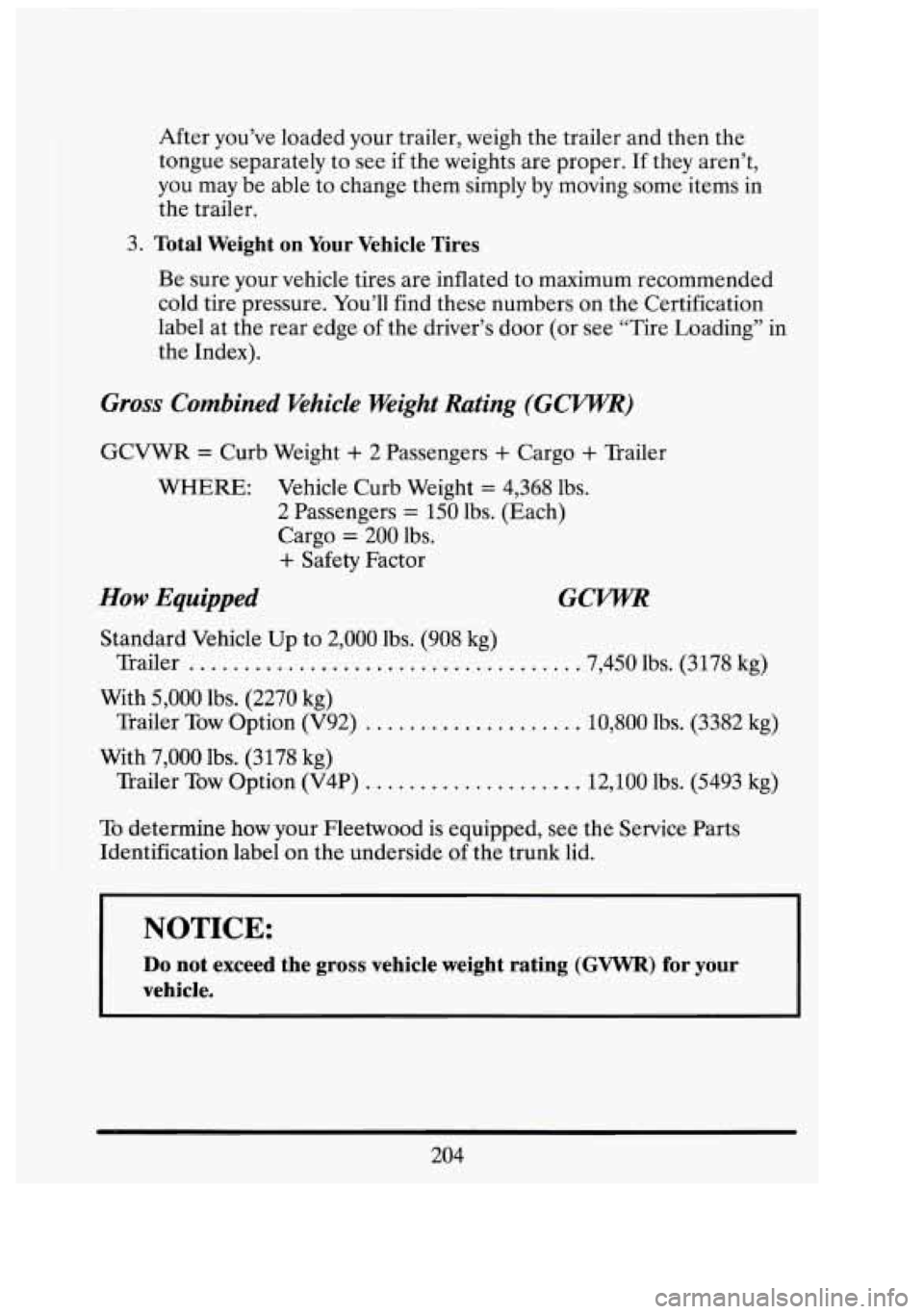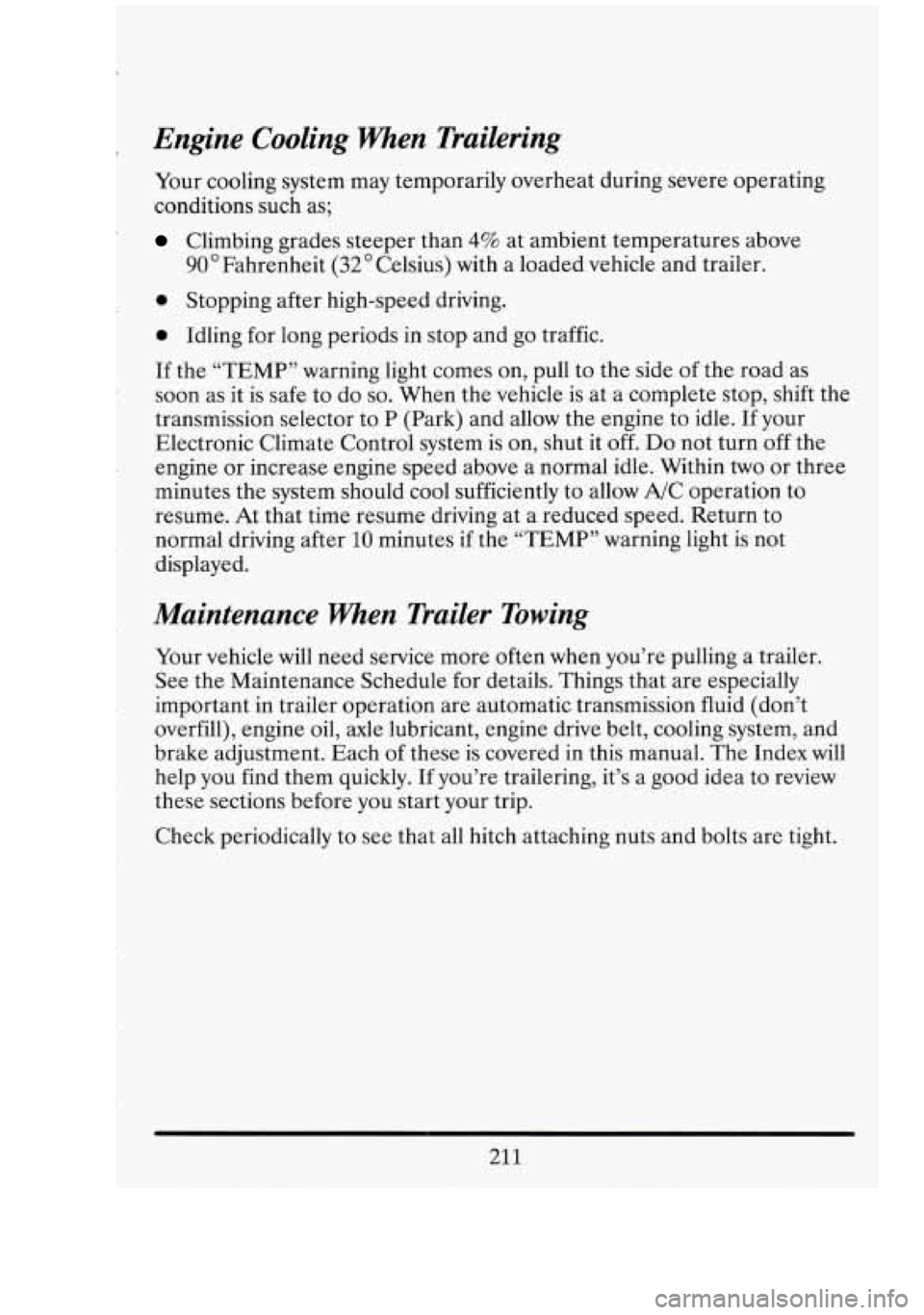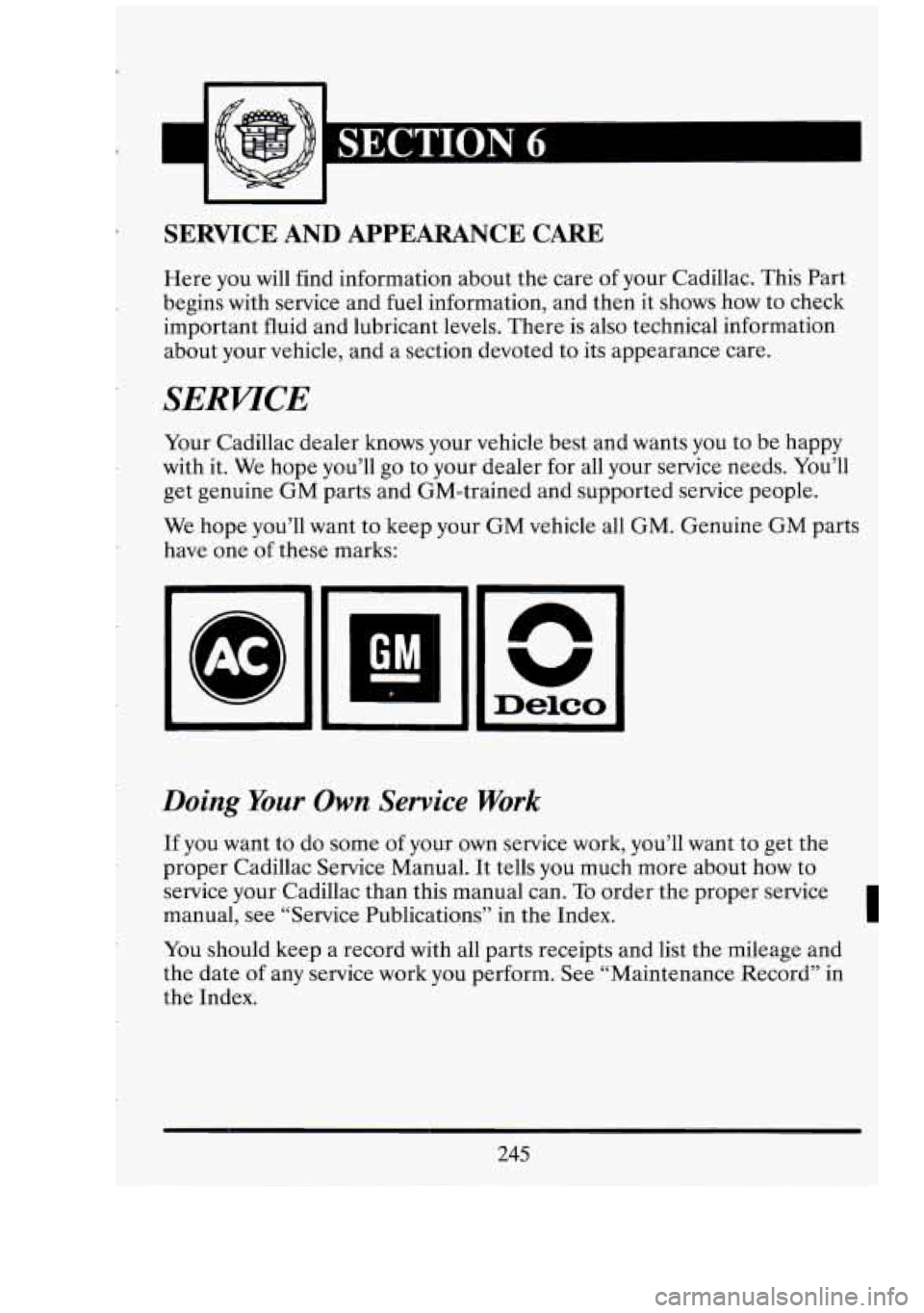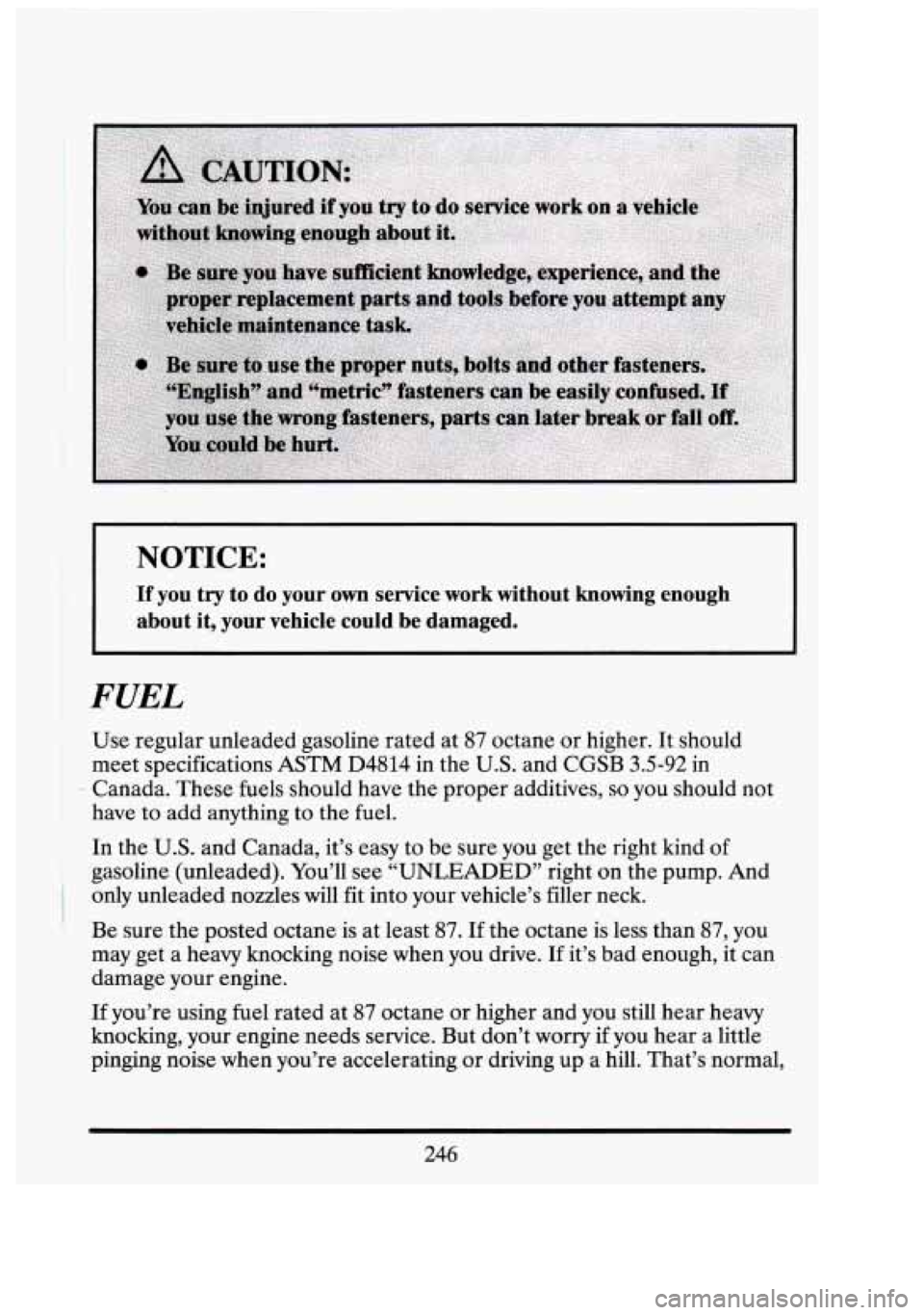Page 217 of 398

I I
31 i
After you’ve loaded your trailer, weigh the trailer and then the
tongue separately to see if the weights are proper. If they aren’t,
you may be able to change them simply by moving some items in
the trailer.
3.
Total Weight on Your Vehicle Tires
Be sure your vehicle tires are inflated to maximum recommended
cold tire pressure. You’ll find these numbers on the Certification
label at the rear edge
of the driver’s door (or see “Tire Loading’’ in
the Index).
Gross Combined Vehicle Weight Rating (GCvmC)
GCVWR = Curb Weight + 2 Passengers + Cargo + Trailer
WHERE: Vehicle Curb Weight
= 4,368 lbs.
2 Passengers = 150 lbs. (Each)
Cargo
= 200 lbs.
+ Safety Factor
How Equipped GCWR
Standard Vehicle Up to 2,000 lbs. (908 kg)
With 5,000 lbs. (2270 kg)
With 7,000 lbs. (3178 kg) Trailer
................................... .7,450
lbs. (3178 kg)
Trailer Tow Option (V92)
.................... 10,800 lbs. (3382 kg)
Trailer Tow Option (V4P)
.................... 12,100 lbs. (5493 kg)
To determine how your Fleetwood is equipped, see the Service Parts
Identification label on the underside
of the trunk lid.
EI
nl
n I
NOTICE:
Do not exceed the gross vehicle weight rating (GVWR) for your
vehicle.
I I -
204
Page 224 of 398

Engine Cooling When Trailering
Your cooling system may temporarily overheat during severe operating
conditions such as;
Climbing grades steeper than 4% at ambient temperatures above
90’Fahrenheit (32O Celsius)
with a loaded vehicle and trailer.
0 Stopping after high-speed driving.
0 Idling for long periods in stop and go traffic.
If the “TEMP” warning light comes on, pull
to the side of the road as
soon as it is safe to do
so. When the vehicle is at a complete stop, shift the
transmission selector to P (Park) and allow the engine to idle. If your
Electronic Climate Control system is on, shut it
off. Do not turn off the
engine or increase engine speed above a normal idle. Within
two or three
minutes the system should cool sufficiently to allow A/C operation to
resume. At that time resume driving at a reduced speed. Return to
normal driving after
10 minutes if the “TEMP” warning light is not
displayed.
Maintenance when Trailer Towing
Your vehicle will need service more often when you’re pulling a trailer.
See the Maintenance Schedule for details. Things that are especially
important in trailer operation are automatic transmission fluid (don’t
overfill), engine oil, axle lubricant, engine drive belt, cooling system, and
brake adjustment. Each of these is covered in this manual. The Index will
help you find them quickly. If you’re trailering, it’s a good idea to review
these sections before you start your trip.
Check periodically to
see that all hitch attaching nuts and bolts are tight.
21
1
Page 231 of 398
I
I
10. Now start the vehicle with the good battery and run the engine for a
11. Try to start the vehicle with the dead battery.
while.
If it won't start after a few tries, it probably needs service.
12. Remove the cables in reverse order to prevent electrical shorting.
Take care that they don't touch each other or any other metal.
218
I
I
Page 233 of 398
When the towing service arrives, let the tow operator know that this
manual contains detailed towing instructions and illustrations. The
operator may want to see them.
When your vehicle is being towed, have the ignition
key off. The steering
wheel should be clamped in a straight-ahead position, with a clamping
device designed for towing service.
Do not use the vehicle's steering
column lock
for this. The transmission should be in Neutral and the
parking brake released.
Don't have your vehicle towed on the rear wheels, unless you must. If the
vehicle must be towed
on the rear wheels, don't go more than 35 mph (56
km/h) or farther than 50 des (80 km) or your transmission will be damaged.
:!I
u 'I
f
220
Page 237 of 398

NOTICE:
If your engine catches fire because you keep driving with no
coolant, your vehicle can be badly damaged. The costly repairs \
would not be covered by your warranty.
IfNo Steam Is Coming From Your Engine
If you get the overheat warning but see or hear no steam, the problem
may not be too serious. Sometimes the engine can get a little too hot
when you:
0 Climb a long hill on a hot day.
Stop after high speed driving.
0 Idle for long periods in traffic.
Tow a trailer.
I
If you get the overheat warning with no sign of steam, try this for a
minute or
so:
i3‘ I
1. Turn off your air conditioner.
2. Turn on your heater to full hot at the highest fan speed and open the
3. If you’re in a traffic jam, shift to “N” (Neutral).
window
as necessary.
If you no longer have the overheat warning, you can drive. Just to be safe,
drive slower
for about ten minutes. If the warning doesn’t come back on,
you can drive normally.
If the warning continues, pull over, stop, and park your vehicle right
away.
If there’s still no sign of steam, you can idle the engine for two or three
minutes while you’re parked, to see if the warning stops. But then, if you
still have the warning, TURN
OFF THE ENGINE AND GET
EVERYONE OUT OF THE VEHICLE until it cools down.
You may decide not to lift the hood but to get service help right away.
3
224
Page 239 of 398
I
The coolant level should be at or above the seam inside the surge tank. If
it isn’t, you may have a leak in the radiator hoses, heater hoses, radiator,
water pump or somewhere else in the cooling system.
NOTICE:
Engine damage from running your engine without coolant isn’t \
covered
by your warranty.
If there seems to be no leak, check to see if the electric engine fans are
running.
If the engine is overheating, both fans should be running. If they
aren’t, your vehicle needs service.
226
Pl i
Page 258 of 398

SERVICE AND APPEARANCE CARE
Here you will find information about the care of your Cadillac. This Part
begins with service and fuel information, and then
it shows how to check
important fluid and lubricant levels. There
is also technical information
about your vehicle, and a section devoted to
its appearance care.
SERVICE
Your Cadillac dealer knows your vehicle best and wants you to be happy
with it. We hope you’ll go to your dealer for all your service needs. You’ll
get genuine
GM parts and GM-trained and supported service people.
We hope you’ll want to keep your GM vehicle all GM. Genuine GM parts
have one
of these marks:
Doing Your Own Service Work
If you want to do some of your own service work, you’ll want to get the
proper Cadillac Service Manual. It tells you much more about how to
service your Cadillac than this manual can.
To order the proper service
manual, see “Service Publications”
in the Index. I
You should keep a record with all parts receipts and list the mileage and
the date
of any service work you perform. See “Maintenance Record” in
the Index.
245
Page 259 of 398

NOTICE:
If you try to do your own service work without knowing enough
about it, your vehicle could be damaged.
I
FUEL
Use regular unleaded gasoline rated at 87 octane or higher. It should
meet specifications
ASTM D4814 in the U.S. and CGSB 3.5-92 in
have to add anything to the fuel.
In the U.S. .and Canada, it’s easy to be sure you get the right kind of
gasoline. (unleaded). You’ll see “UNLEADED” right.
on the pump. And
Be sure the posted octane is at least
87. If the octane is less than 87, you
may get a heavy knocking noise when you drive. If it’s bad. enough, it can
damage your engine.
‘1 Canada. These fuels should have the proper additives, so you should not
I ’ only unleaded nozzles will fit into your vehicle’s filler neck.
i
If you’re using fuel rated at 87 octane or higher and you still hear heavy
knocking, your engine needs service. But don’t worry if you hear a little
pinging noise when you’re accelerating or driving up a. hill. That’s normal,
246
op
3’
-’ I
I n
Lll
“I
I -1
I
r7